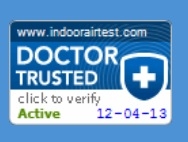News
Mold Sampling Strategies in the Indoor Environment
Molds release thousands of microscopic cells called “spores”, which are lightweight, easily airborne and spread to surrounding areas through the air.
Tampa, Fl -- Molds are fungi that can be found both outdoors and indoors. They grow best in warm, damp and humid conditions. If you have damp or wet spots in your house, you will probably get mold. Mold can cause health problems. Inhaling or touching mold or mold spores may cause allergic reactions or asthma attacks in sensitive people. It can cause fungal infections. In addition, mold exposure may irritate your eyes, skin, nose, throat and lungs.
Molds release thousands of microscopic cells called “spores”, which are lightweight, easily airborne and spread to surrounding areas through the air. Mold growth on surfaces can often be seen as a colored spot, frequently green, gray, brown, black or white. It commonly appears as a powdery, fuzzy, or hair-like material. Actively growing molds typically produce odors, sometimes described as earthy, moldy or mildew. The spores must have both food and moisture to actually start growing, similar to plant seeds.
Mold Sampling:
The method of choice for assessing potential exposures to airborne molds and mycotoxins in indoor environments involves the collection and identification of fungal propagules. Currently, there are numerous sampling methods available to measure fungal concentrations in the environment. Source sampling, which includes methods such as swab, tape, bulk, and dust, is commonly used to identify indoor fungi. These source sampling methods are “necessary adjuncts” to air sampling, especially when air sampling might result in false-negative findings.
Air sampling is one of the most common methods used to assess fungal levels in indoor environments. Many studies have related human health effects, such as increases in allergic and asthmatic respiratory symptoms, to airborne fungal spores. As the health effects of fungal exposure are mainly respiratory, air sampling is believed to be adequate to represent the exposure. However, fungal spores have been found to exhibit varying patterns in their release into the air depending on several environmental factors.
Spatial or Location Variables:
Sampling strategies can be affected by the layout of a building or home components or zones. Therefore, the objective of sampling may be to determine whether mold spores from a damp attic are being dispersed into occupied zones. Consequently, during the inspection prior to sampling, it is important to determine whether pathways occur that would allow for transport of spores from the attic to occupied zones.
Indoor activities such as vacuum cleaner operation are known to elevate bioaerosol concentrations. Other activities such as walking around and sitting up and down on upholstered furniture can result in a “personal cloud effect” wherein the airborne particle level in other parts of the same room will be low. It may be important, therefore for the investigator to determine whether personal or area sampling is appropriate.
Temporal (Time) Variables
Sample results in a building are potentially affected by variables including human activity patterns, AHU system operation, facility operations, and climatic or seasonal variations such as alternating rainy and dry periods.
For example, sampling for culturable fungi during a prolonged dry season will be less likely to detect water indicatior fungi from leak prone envelope walls than will sampling during a rainy period when the building envelope is leaky and wet. Similarly, sampling for human shed bacteria in a office room during unoccupied nighttime hours will yield different results than will sampling in the same office room with many active occupants.
Temporal changes in the building envelope affect air sampling results. Solar heating of the building envelope causes air near perimeter walls to warm and move upward. Thus, divergent bioaerosol sampling results can occur in the morning as compared to the afternoon. In this case sampling should be repeated at least several times daily (morning and afternoon) at each testing site. Seasonal changes in moisture levels including condensation potential on the inner surface (closet to occupants) of the envelope wall can affect the ecology of molds on the wall surface and in room air. Thus, during warm, humid, seasons condensation and active mold growth can occur on the wall surface especially in depressurized buildings. However, surface and air sampling results obtained in the same areas during the heating season may be different because of the absence or dampness.
Case (Complaint) vs. Control (Non Complaint) Zones
Establishing a baseline of the facility is essential to determining the course of action for any necessary remediation action. The baseline will also provide invaluable information to determine the effectiveness of the remedial activity.
Occupant complaints in buildings may be environmentally based (dampness, water leaks, visible mold growth, etc.), health related (example: upper respiratory irritation, allergy, infection), or both of these. It should be recognized that results of microbial sampling alone cannot be used to determine whether adverse health outcomes have occurred.
Additional factors to consider with regard to microbial sampling strategy in complaint/noncompliant areas include the timing of the sampling evaluation as well as the methodology to collect the samples.
The methodology used to collect samples in complaint/noncompliant zones should simulate normal occupant exposure conditions. Collection of air samples from a wall cavity in a complaint zone when wall board or other material are being aggressively disturbed (example: by drilling or pounding) does not represent normal bioaerosol exposure of room occupants unless the determination is for the identification of fungal element types within the cavity only. Interstitial wall cavity inspection can be augmented via thermography and/or specialized non-invasive cameras to visually monitor the interior components of the wall cavity. An appropriate sampling strategy should specify “normal occupant activities and conditions” at the time of air sample collection in both complaint and non complaint areas.
Building Practitioner vs. Medical Practitioner or Both
A medical practitioner diagnosis of the respective patient is necessary to ascertain if the building occupant/patient has had building related illness (BRI). Both the medical analyses as well as environmental analysis are essential to determining a potential cause effect relationship. However, careful inspection of a building for dampness/moisture damage can lead to a microbial sampling strategy, the results of which can provide useful information to a physician or epidemiologist in associating environmental conditions with occupant health complaints.
Potential Health Effects of Indoor Mold
Exposure to mold can occur when airborne mold cells, mostly spores, are inhaled. We breathe in these cells every day, indoors and out. Usually these exposures do not present a health risk. But when exposure is great, some individuals, particularly those with allergies and asthma, can experience illness that could be mild to serious or anywhere in between. The following is a description of the health problems that can be caused by exposure to mold.
* Allergic Illness: When mold cells are inhaled and land in the respiratory tract, the body’s immune system’s response to those invading cells can cause allergic illness. The immune system tries to destroy the mold as it would an agent, like a flu virus, that might cause infection. In a relatively small portion of the population (about 10 percent of people in the U.S.), the immune system overreacts and causes the allergic response that results in symptoms such as runny nose, scratchy throat and sneezing. Most of us know this allergic illness as “hay fever” or “allergic rhinitis.”
* Asthma: Asthma is a lung disease in which the airways that carry oxygen to the lungs can partially close, causing breathing difficulties ranging from mild (such as a dry cough) to life-threatening (inability to breathe). North Carolina is in the midst of what is being called a world-wide asthma epidemic. A recent survey of North Carolina middle school children revealed that 10 percent had been diagnosed with asthma and another 17 percent had asthma symptoms that had never been diagnosed. More than half of asthmatics have respiratory allergies, often to mold. Molds can trigger asthma episodes in sensitive asthmatics.
* Infection: Some mold species can cause respiratory infection when the live mold invades the tissues of the lungs or respiratory tract. This is not a significant risk for healthy people, but can be dangerous for individuals with severely weakened immune systems.
* Toxic Effects: Very large doses of certain molds, whether inhaled or ingested, can result in poisoning caused by toxins, called mycotoxins, in the mold cells. It is not clear whether an individual can receive a high enough exposure to mold growing indoors to experience these toxic effects.
For assistance on assessing your building or home call the experts at Building Health Check at 1-800-422-7873 ext 802.
About Building Health Check/Pure Air Control Services:
Alan Wozniak founded Pure Air Control Services, Inc. in 1984 as a small mechanical contracting firm. Today, the firm sets the industry standard for indoor environmental quality diagnosis and remediation. Pure Air has serviced more than 600 million square feet of indoor environments in over 10,000 facilities.
Pure Air Control Services nationally performed services include: Building Sciences Evaluation; LEED Building Assessments, Building Health Check; an AIHA accredited Environmental Microbiology Laboratory; Environmental Project Management; Duct Cleaning and Mold Remediation Services, among other indoor environmental services.
For more information on Pure Air Controls Services, Inc. please contact Alan Wozniak or Cy Garner, at (800) 422-7873 x 804, or visit www.pureaircontrols.com.

More News

IAQ Test Kits (DIY), PURE-Steam Coil Cleaning and PURE-Decon Room Treatment Showcased at the Annual FRACCA Conference
This annual event provides an opportunity for licensed contractors throughout the State of Florida to obtain all 14 state-required hours of continuing education over the course of the two-day event.
Released On: 3/8/2014
Views: 4346

Free Legionella Webinar: Detection & Identification Workshop
Although this type of bacteria was around before1976, more illness from Legionnaires' disease is being detected now. Due to consumer awareness, added research and technological advances in healthcare Legionnaires disease identification is becomi ...
Released On: 3/4/2014
Views: 4201

Why Some High-Performance Buildings Are Failing?
Performance of a building depends on its structured integrity, preventive maintenance, as well as periodical monitoring of the environmental conditions essential for its functionality.
Released On: 2/19/2014
Views: 4231

Legionnaire’s – What You Should Know About The Potential Deadly Bacteria
According to Building Operating Management magazine, expert Victor Yu, MD, Professor of Medicine, University of Pittsburgh; Chief, Infectious Disease Section, VA Medical Center, Pittsburgh, PA, disclosed that “Up to 70% of all buildings greater t ...
Released On: 2/18/2014
Views: 3788

Managing of Indoor Environments: Problems and Solutions - IEQ WEBINAR
Released On: 1/22/2014
Views: 3686

Save Energy and Improve Indoor Air Quality (IAQ) with PURE-Steam Deep Coil Cleaning
High efficiency coils are extremely susceptible to blockage from dust accumulation because once lodged deeply within the fins bacteria and mold may initiate growth, which not only compounds the blockage problems but also gives rise to excessive o ...
Released On: 1/8/2014
Views: 6462

January is National Radon Action Month
Exposure to radon is the second leading cause of lung cancer after smoking. Radon is an odorless, tasteless and invisible gas produced by the decay of naturally occurring uranium in soil and water.
Released On: 1/8/2014
Views: 4127

Why indoor air quality is important to all of us?
World Health Organization (WHO Guidelines for Indoor Air Quality, 2009) concluded that the most important effect is increased prevalence of respiratory symptoms, allergies and asthma, as well as perturbation of the immunological systems
Released On: 12/31/2013
Views: 4175

Pure Air Control Services Launches New Interactive Website
The website is a true indoor environmental resource for the private and public sector including consumers, educational facilities e.g. schools, universities, along with city, county state and federal governments, healthcare and the public sector.
Released On: 12/20/2013
Views: 3179

Pure Air Control Services Awarded Certification from Doctor Trusted
“We are very proud to have been given the opportunity to display that we are a Doctor Trusted recipient. We will continue as always to help provide our customers with a great products and services,” stated Dr. Rajiv Sahay, environmental analytica ...
Released On: 12/11/2013
Views: 4122

IndoorAirTest.com Receives Seal of Approval by Doctor Trusted
IndoorAirtest.com is very proud to have a Doctor Trusted seal of approval displayed on our website, giving our customers more confidence when shopping with us.
Released On: 12/4/2013
Views: 4550

PURE-Decon/Sanosil, Reduces Sick Days Caused by Infection
Released On: 10/2/2013
Views: 3474

Controlling Asthma & Allergy Triggers Through Source Identification
The assessment of allergens in a house dust sample is an essential step for allergen-avoidance and provides information essential for allergen-reducing measures, in addition to managing the indoor environment from a health and hygiene point of view
Released On: 9/18/2013
Views: 5569

Hospitals Get a “Clean Bill of Health” with Innovative IAQ/Energy Solutions
Healthcare-associated infections (HAIs) are infections that patients acquire during the course of receiving healthcare treatment for other conditions.
Released On: 7/31/2013
Views: 4594

How Safe is Formaldehyde in our Buildings and Homes?
Released On: 7/17/2013
Views: 4865

Commercial Energy Solutions Seminar July 26, 2013
Released On: 7/11/2013
Views: 4926

Health Risks Associated With Indoor Microbes
Some common and frequently reported microbes of the indoor environment include, but are not limited to, viruses, bacteria, mycoplasma, mold (fungi), yeast, protozoa, etc.
Released On: 6/26/2013
Views: 6078

Aspergillosis: A Cause for Indoor Concerns?
In indoor environments, this fungus can be transported from outside or may propagate on building materials such as cellulose rich sheet rocks, etc. and can generally be isolated from floors, carpets, mattress dust, Heating Ventilation Air Conditi ...
Released On: 6/19/2013
Views: 10782

Map
Pure Air Control, Services, Inc.
Get DirectionsPure Air Control, Services, Inc.
-
4911 Creekside Drive
Clearwater, Florida 33760
United States - 1 (800) 422-7873


